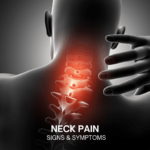Understanding and Managing Neck Pain: A Comprehensive Guide
Neck pain is a common ailment that affects millions of people worldwide. It can range from a mild discomfort to severe, debilitating pain that can impact daily activities. Understanding the causes, symptoms, and treatment options for neck pain is crucial for effective management and prevention.
Causes of Neck Pain
Neck pain can arise from a variety of sources, including:
- Muscle Strain: Overuse or poor posture can strain the muscles in the neck. This is common among individuals who spend long hours working at a desk, using a computer, or looking down at a smartphone.
- Injury: Sudden movements, falls, or accidents can result in neck injuries. Whiplash, a common injury from car accidents, occurs when the head is jerked backward and then forward, straining the neck muscles and ligaments.
- Degenerative Diseases: Conditions such as osteoarthritis or degenerative disc disease can cause chronic neck pain. These conditions are more common with aging and can lead to the breakdown of the cartilage and discs in the neck.
- Herniated Discs: A herniated disc in the cervical spine can press on nerves, causing pain that radiates down the arms.
- Medical Conditions: Certain medical conditions, including rheumatoid arthritis, meningitis, or infections, can also cause neck pain.
Symptoms of Neck Pain
Neck pain symptoms can vary depending on the underlying cause. Common symptoms include:
- Pain and Stiffness: Generalized pain and stiffness in the neck, which may worsen with movement.
- Radiating Pain: Pain that radiates to the shoulders, arms, or back.
- Headaches: Neck pain can often lead to tension headaches.
- Numbness or Tingling: Sensations of numbness or tingling in the arms or hands, often due to nerve compression.
- Muscle Weakness: Weakness in the muscles of the arms or hands.
Diagnosing Neck Pain
Diagnosing the cause of neck pain typically involves a combination of patient history, physical examination, and diagnostic tests. During the physical examination, the doctor will assess the range of motion, strength, and reflexes. They may also palpate the neck to identify tender areas or muscle spasms.
Diagnostic tests may include:
- X-rays: To identify bone abnormalities, fractures, or arthritis.
- MRI or CT scans: To provide detailed images of soft tissues, including discs and nerves.
- Electromyography (EMG): To evaluate the electrical activity of muscles and identify nerve damage.
Treatment Options for Neck Pain
The treatment for neck pain depends on the underlying cause and severity of the condition. Common treatment options include:
Non-Surgical Treatments
- Rest and Activity Modification: Avoiding activities that exacerbate the pain can help reduce inflammation and promote healing.
- Medications: Over-the-counter pain relievers, such as ibuprofen or acetaminophen, can help manage pain. In some cases, prescription medications, including muscle relaxants or stronger pain relievers, may be necessary.
- Physical Therapy: A physical therapist can design a customized exercise program to strengthen the neck muscles, improve flexibility, and reduce pain. Techniques may include stretching, strengthening exercises, and posture training.
- Heat and Cold Therapy: Applying heat or cold packs to the neck can help reduce inflammation and alleviate pain.
- Cervical Collar: In some cases, a soft cervical collar can provide support and limit movement, allowing the neck muscles to rest.
- Alternative Therapies: Techniques such as acupuncture, chiropractic care, or massage therapy can provide relief for some individuals.
Surgical Treatments
Surgery is typically considered a last resort when conservative treatments have failed, and the pain is severe or associated with neurological deficits. Surgical options may include:
- Discectomy: Removal of a herniated disc that is pressing on a nerve.
- Laminectomy: Removal of part of the vertebra to relieve pressure on the spinal cord.
- Fusion: Joining two or more vertebrae to provide stability to the spine.
Preventing Neck Pain
Preventing neck pain involves adopting healthy habits and making ergonomic adjustments to reduce strain on the neck. Here are some tips for prevention:
- Maintain Good Posture: Ensure that your head is aligned with your spine, especially when sitting or standing for long periods. Keep your computer screen at eye level and avoid looking down at your phone for extended periods.
- Take Frequent Breaks: If you work at a desk or use a computer, take regular breaks to stretch and move around. This helps prevent muscle stiffness and strain.
- Use Ergonomic Equipment: Ensure that your workstation is set up ergonomically. Use an adjustable chair, and position your keyboard and mouse at a comfortable height to avoid straining your neck and shoulders.
- Exercise Regularly: Engage in regular physical activity to strengthen the muscles supporting your neck and improve overall flexibility.
- Stay Hydrated: Drinking plenty of water helps maintain the health of your spinal discs.
- Sleep Position: Use a supportive pillow and sleep in a position that maintains the natural curve of your neck. Avoid sleeping on your stomach, as it can strain your neck.
When to See a Doctor
While most cases of neck pain improve with conservative treatment, it’s important to seek medical attention if you experience:
- Severe pain that does not improve with rest and medication.
- Pain that radiates down your arms or legs.
- Numbness, tingling, or weakness in your arms or hands.
- Difficulty moving your head or maintaining your balance.
- Symptoms of an infection, such as fever and chills.
Conclusion
Neck pain is a prevalent condition that can significantly impact your quality of life. Understanding the causes, symptoms, and treatment options is essential for effective management and prevention. By adopting healthy habits, making ergonomic adjustments, and seeking appropriate medical care when necessary, you can alleviate neck pain and maintain a healthy, active lifestyle. If you experience persistent or severe neck pain, consult with a healthcare professional to determine the best course of action for your specific condition.





